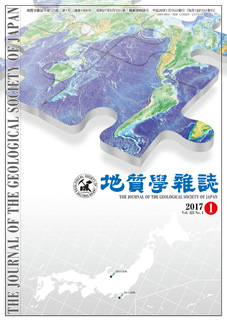
- |<
- <
- 1
- >
- >|
-
小山内 康人, 北野 一平, 中野 伸彦, 足立 達朗, 米村 和紘, 吉本 紋, 宮下 由香里, 米虫 聡, 小松 正幸2021 年127 巻1 号 p. 1-24
発行日: 2021/01/15
公開日: 2021/04/16
ジャーナル フリー
電子付録愛媛県西部八幡浜大島の大島変成岩体は,その地体構造上の意義・帰属が長年に渡り検討されてきた.本論ではジルコンおよびモナザイトのU(-Th)-Pb精密年代測定により大島変成岩体および関連岩石の年代学的特徴を明らかにした.大島変成岩体は約2000-140 Maの砕屑性ジルコン年代で特徴づけられ,約120 Maの主要高温変成作用,約110 Maのハンレイ岩・閃緑岩・トーナル岩の貫入,約100 Maのシュードタキライト脈形成を伴う脆性変形を経験したことが明らかになった.一方,大島変成岩体の南部に位置する地大島北端に分布する花崗岩質マイロナイトは約170 Maの珪長質火成活動に由来し,大島変成岩体とは全く異なる起源をもつことが明らかになった.大島変成岩体の年代学的特徴は,肥後変成岩体と極めて類似するとともに関東山地や阿武隈・日立地域の白亜紀変成・火成岩体とも対比可能であり,一連の大規模火成・変成コンプレックスが改めて認識された.
抄録全体を表示PDF形式でダウンロード (9359K) -
末岡 茂, 島田 耕史, 照沢 秀司, 岩野 英樹, 檀原 徹, 小北 康弘, 平田 岳史2021 年127 巻1 号 p. 25-39
発行日: 2021/01/15
公開日: 2021/04/16
ジャーナル フリー
電子付録南九州せん断帯に分布する破砕帯の活動時期の制約のため,紫尾山花崗閃緑岩体から再加熱を被っていない試料2点と破砕帯に切られたアプライト脈沿いの試料1点に,フィッション・トラック(FT)およびU-Pb解析を適用した.ジルコンU-Pb年代は14.0~13.5 Ma,ジルコンFT年代は14.7~13.7 Ma,アパタイトFT年代は12.6~10.0 Maを示した.本岩体は14.0~13.5 Maに浅所に貫入し,60~130℃以下まで急冷したと推定された.平八重型と楠八重型の岩型で,貫入時期と冷却史に違いは見られなかった.せん断センスの観察によれば,破砕帯は約200℃以上でアプライト脈を複数回変位させている.破砕帯の活動時期は,アプライト脈の貫入時期(10.0±0.8 Ma)頃で,岩体の貫入・初期冷却に伴う膨張・収縮による破砕ではなく,岩体冷却後のテクトニックな作用に起因する可能性が高い.
抄録全体を表示PDF形式でダウンロード (5472K) -
馬塲園 明, 今岡 照喜, 曽根原 崇文, 八木 公史, 井川 寿之2021 年127 巻1 号 p. 41-50
発行日: 2021/01/15
公開日: 2021/04/16
ジャーナル フリー山口県北西部に分布する後期白亜紀阿武層群の長門層原岡山安山岩部層と白滝山層天井ヶ岳安山岩部層について,野外調査,岩石記載,全岩化学分析,および斜長石K-Ar年代測定を行い,その層序学的位置について再検討した.その結果,両安山岩部層は,①阿武層群の火山性ベーズン内だけでなく外側の関門層群も不整合に覆うこと,②阿武層群(約90-80 Ma)よりも有意に若いこと(73-70 Ma),③阿武層群中に挟在する安山岩と地球化学的特徴がわずかながら異なることが分かった.したがって,両安山岩を阿武層群から切り離し,「原岡山安山岩」と改称し,山口県長門市-下関市豊北町に分布し,関門層群や阿武層群を不整合に覆う白亜紀最末期の安山岩として再定義した.原岡山安山岩の存在は,カルデラ形成を伴うイグニンブライト・フレアアップ(阿武層群)から定常的な火山活動への移行が,少なくとも約70 Maまで遡ることを示唆する.
抄録全体を表示PDF形式でダウンロード (5214K)
-
志村 侑亮, 中村 佳博, 常盤 哲也, 杉本 大志, 水戸 創也2021 年127 巻1 号 p. 51-58
発行日: 2021/01/15
公開日: 2021/04/16
ジャーナル フリー
電子付録We conducted U-Pb dating of detrital zircons from three clastic rock samples, which have been classified into the Chichibu Belt in the Koshibu-gawa area, central Akaishi Mountains. U-Pb ages of the samples fall into two main age groups at 280-100 Ma and 2600-1700 Ma. The youngest single grain ages are 105.5±1.3 Ma, 109.6±1.2 Ma, and 111.1±1.9 Ma, and the youngest cluster ages are 115.9±1.0 Ma, 115.1±0.4 Ma, and 113.1±1.3 Ma. These Aptian to Albian (latest Early Cretaceous) ages are considerably younger than previously reported youngest ages from the Jurassic accretionary complex of the Chichibu Belt in the southern part of the Koshibu-gawa area (Okuchausu-yama area). Our results indicate that the geological bodies, including clastic rocks studied in the Koshibu-gawa area, should be assigned to the Cretaceous accretionary complex of the Shimanto Belt, and not to the Jurassic accretionary complex of the Chichibu Belt. Reexamination of the structural evolution and geological architecture in the Koshibu-gawa area is thus warranted.
抄録全体を表示PDF形式でダウンロード (3495K)
-
塩谷 輝, 道林 克禎, 纐纈 佑衣, 榎並 正樹2021 年127 巻1 号 p. 59-65
発行日: 2021/01/15
公開日: 2021/04/16
ジャーナル フリーThe Shibukawa region of the Sanbagawa belt, central Japan, is one of the historic jadeite localities in Japan. Although its petrological and mineralogical characteristics of the locality were briefly reported over 35 years ago, no further studies have been conducted since the disappearance of the jadeite-bearing outcrop. Recently, jadeite was discovered within a veinlet in a host dunite boulder, a member of an ultrabasic body that is surrounded by the Sanbagawa crystalline schists in the Shibukawa region. The veinlet is composed mainly of diopside, OH-bearing grossular, jadeite, chlorite, pargasite and serpentine. Relict olivine and spinel, which were probably members of the host dunite, rarely occur in the veinlet. The jadeite grains vary from <1 to 50 µm in size, and occur as patchy aggregates with amoeba-shaped grossular grains. The jadeite grains have Na2O and Al2O3 contents of 14.7-15.4 wt.% and 24.3-25.5 wt.%, respectively, and are 91-98% jadeite contents [(Na-Fe3+)×100].
抄録全体を表示PDF形式でダウンロード (5103K)
- |<
- <
- 1
- >
- >|